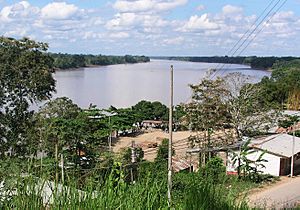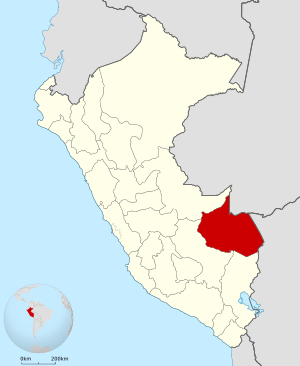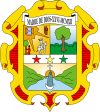Department of Madre de Dios facts for kids
Quick facts for kids
Department of Madre de Dios
|
|||
|---|---|---|---|

|
|||
|
|||

Location of the department of Madre de Dios in Peru
|
|||
| Country | Peru | ||
| Subdivisions | 3 provinces and 11 districts | ||
| Capital | Puerto Maldonado | ||
| Area | |||
| • Total | 85,300.54 km2 (32,934.72 sq mi) | ||
| Highest elevation | 3,932 m (12,900 ft) | ||
| Lowest elevation | 183 m (600 ft) | ||
| Population
(2017)
|
|||
| • Total | 141,070 | ||
| • Density | 1.65380/km2 (4.28332/sq mi) | ||
| UBIGEO |
17
|
||
| Dialing code | 082 | ||
| ISO 3166 code | PE-MDD | ||
| Principal resources | Cotton, coffee, sugar cane, cacao beans, Brazil nuts, palm oil, gold, rice, coconut, wood. | ||
| Poverty rate | 36.7% | ||
| Percentage of Peru's GDP | 0.37% | ||
| Website | www.regionmadrededios.gob.pe | ||
Madre de Dios (which means "Mother of God" in Spanish) is a region in southeastern Peru. It shares borders with Brazil, Bolivia, and other Peruvian regions like Puno, Cusco, and Ucayali. This area is part of the Amazon Basin, a huge rainforest.
The capital city of Madre de Dios is Puerto Maldonado. It is the third largest region in Peru. However, it has the fewest people living there and is the least crowded. The name "Madre de Dios" comes from the Madre de Dios River. This river is a branch of the Amazon River. Spanish explorers named it after the Virgin Mary.
Contents
Exploring the Geography of Madre de Dios
This region is mostly covered by the Amazon rainforest. The weather here is warm and humid. Average temperatures are around 26°C (79°F). It can get as hot as 34°C (93°F) and as cool as 21°C (70°F). The rainy season lasts from December to March. During this time, heavy rains make the rivers swell and sometimes overflow. About 3 meters (10 feet) of rain can fall each year.
Rivers and Travel in Madre de Dios
The Madre de Dios River is very important here. Other major rivers in the area include the Inambari, Tambopata, Manu, and Las Piedras. Because the region is so big and has few roads, rivers are the main way to travel between towns. Most human activities happen along the riverbanks.
A new road opened in 2011. It connects Brazil and Peru, making it easier to travel to and from this isolated area. The main highway links Puerto Maldonado to Cusco, which is about 510 km (317 miles) away. This road is part of the Interoceanic Road. It connects the Pacific and Atlantic Oceans. Flying between Cusco and Puerto Maldonado is still the fastest way to travel.
There is also a road from Puerto Maldonado to Laberinto, a mining town. Another road connects Pillcopata village to Itahuania. This road is about 350 km (217 miles) long. It can be hard to use during the rainy season. There is also a dirt road to Infierno, a native community. The Ese'ejas people live there.
Economy and Resources in Madre de Dios
Madre de Dios relies on its natural resources for its economy. There are almost no factories here.
Main Agricultural Products
The main crops grown in the region are:
- Cotton
- Coffee
- Sugarcane
- Cacao beans (used to make chocolate)
- Brazil nuts
- Palm oil
Gold Mining and its Impact
Gold mining is another big industry. It mostly happens near the Inambari and Madre de Dios rivers. This activity has caused a lot of deforestation, which means forests are cut down. Gold miners often use liquid mercury to get gold from the soil. They sometimes touch the mercury with their bare hands. To clean the gold, they burn off the mercury. This releases mercury into the air, which can harm the environment. Mercury can also get into the food chain. It builds up in fish and birds. People who eat these fish can get sick. Mercury can cause problems with the brain and other health issues.
Ecotourism and Conservation Efforts
Ecotourism is a growing industry in Madre de Dios. Many lodges in the Manu and Tambopata areas offer nature tours. These places are part of a larger conservation area. New laws are helping private companies create areas for conservation or ecotourism. This helps protect more land. Local communities are also getting involved in ecotourism. This helps them earn money while protecting the forests.
Political Divisions of Madre de Dios
The region is divided into three main areas called provinces. These provinces are then split into 11 smaller areas called districts.
- Manu (Capital: Salvación)
- Tahuamanu (Capital: Iñapari)
- Tambopata (Capital: Puerto Maldonado)
People and Languages in Madre de Dios
Most people in Madre de Dios speak Spanish. This is because it was the first language learned by 80% of the residents. About 16.5% of the people speak Quechua. Some other native languages are also spoken.
| Province | Quechua | Aymara | Asháninka | Another native language | Spanish | Foreign language | Deaf or mute | Total |
|---|---|---|---|---|---|---|---|---|
| Manu | 5,731 | 239 | 9 | 1,540 | 11,170 | 18 | 16 | 18,723 |
| Tahuamanu | 897 | 166 | 7 | 74 | 8,870 | 94 | 15 | 10,123 |
| Tambopata | 10,202 | 586 | 14 | 481 | 61,387 | 197 | 75 | 72,942 |
| Total | 16,830 | 991 | 30 | 2,095 | 81,427 | 309 | 106 | 101,788 |
| % | 16.53 | 0.97 | 0.03 | 2.06 | 80.00 | 0.30 | 0.10 | 100.00 |
Culture and History
Madre de Dios is home to many ancient Inca ruins. Several native tribes still live deep in the Amazon jungle here.
Places to Visit
Madre de Dios has several important natural reserves:
- Amarakaeri Communal Reserve
- Purús Communal Reserve
- Tambopata National Reserve
Madre de Dios in Stories and Films
This region has been featured in books and movies:
- The movie Fitzcarraldo (1982) was set here. It was based on the life of Carlos Fermín Fitzcarrald, a rubber businessman.
- The science fiction novel Primeval: Shadow of the Jaguar (2008) takes place mostly in Madre de Dios.
- Mother of God: An Extraordinary Journey into the Uncharted Tributaries of the Western Amazon (2014) is a memoir by conservationist Paul Rosolie about his experiences here.
- The memoir Ruthless River: Love and Survival by Raft on the Amazon's Relentless Madre de Dios (2017) by Holly Fitzgerald tells about a rafting trip in 1973.
See also
 In Spanish: Departamento de Madre de Dios para niños
In Spanish: Departamento de Madre de Dios para niños
- Julio Cusurichi Palacios, an environmentalist from the region.



